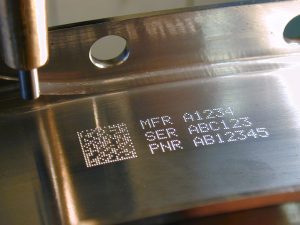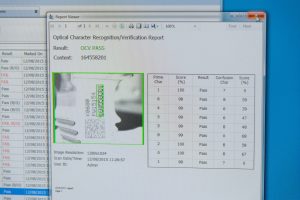Marking and Verification-Should you consider it for part identification?
Part marking and verification
Machine readable identification markings are an essential part of modern manufacturing, inventory control and asset tracking processes. But are you doing enough to verify the quality of your marks? Do you realise the possible consequences of not verifying their quality?
A growing number of industries are recognising the value of part identification using a part marking and verification system to apply and check machine readable codes. Such codes aid quality and traceability in production, ensuring the right parts are used in the right places, and allowing the accurate, timely identification of affected parts when quality deviations are identified. They also simplify maintenance and management activities through the working life of the product, helping operations and maintenance staff track failures and match replacement parts.
The aerospace industry has led the way in the widespread use of permanent, machine readable component marking, but the approach is becoming increasingly popular in other sectors. For suppliers, part marking is now a common part of OEM component specifications, and a growing number of companies are adopting marking approaches as part of their internal quality and traceability processes.
Most modern component marking standards use 2D Data Matrix codes (What is a data matrix code?). Such codes provide a host of benefits in manufacturing environments. They can be applied using a variety of marking technologies, including dot peen, laser, mechanical or chemical etching and ink jet printing. And they incorporate redundancy and check features, which allows the code to remain useable even when dirty or damaged.
For a mark to be useful, it has to be readable. That’s why the all the commonly used marking standards (such as AIM-DPM, AS9132, JES131 and RRES90003) include stringent quality criteria covering dot size, shape, position and contrast under suitable lighting. Most organisations incorporate some form of verification process into their production and quality assurance operations. Unfortunately, some of the most commonly used verification approaches have significant drawbacks, and could potentially result in a ‘verification pass’ that does not meet the required standard.

Marking and Verification by reading
The simplest verification process involves reading the mark, either directly after application or later in production. Machine reading is fast, fully automatic and easy to integrate into even high speed, short cycle production operations. But as a verification process, reading only provides that the mark can be read by the chosen reading equipment in the chosen conditions, a change in either the reading equipment or conditions could easily give a different result on the mark
Here companies can fall foul of the power of modern automated reading equipment. Today’s code readers use sophisticated image processing technology that allows them to read damaged, poorly lit or poor quality marks. For operations and maintenance teams this is a real benefit, as they are able to quickly read more marks than ever before. It can create problems further down the life cycle, however, when a mark needs to be read with an inferior quality reader, or further damage has been made to the mark.
Marking and Verification by lab inspection
At the other end of the scale, companies can inspect marks in the quality laboratory, using microscopes and specialist metrology equipment. That approach helps them ensure that a mark meets the full requirements of its specification, but it is time consuming and expensive to do. In the majority of applications, that means companies can only inspect a small sample of parts, creating the risk that they miss individual deviations. And if a mark fails the laboratory check, the company may have to inspect or recheck hundreds of other marks from the same batch.
The implications of inadequate verification
Failure to ensure that product markings are fully compliant with required standards creates two kinds of problems for manufacturers.
First, there is a real risk that a non-compliant mark will be rejected by the customer, if their equipment can’t provide a satisfactory read upon receipt of the parts, or if their own quality checks identify deviations from the standard. That can be extremely costly and disruptive, especially if the parts in question have already been shipped across the world by the time the deviation is identified.
Second, a mark that doesn’t fully comply with the appropriate standard initially will be less able to accommodate further degradation before becoming unreadable. That stores up problems for in-service use, and can create difficulty in “smart” manufacturing environments where marks are used for tracking components within the production process.
The marking and verification solution
Technology now offers a solution to the verification challenge. Dedicated verification systems – such as the Pryor VeriSmart 2.1 – can now be installed on the production line, either directly on the marking equipment or at another suitable point on the line. These systems operate on a similar principle to conventional code reading systems, but they use a high resolution imaging camera, together with tight control of lighting and reading conditions. Verification systems like these don’t just check that the correct data has been marked on the part, they also ensure that the size, shape and position of the dots complies fully with the required standards. And they can do all that within the cycle time of the machine, operating at speeds of up to two parts per second in some high-volume applications.
Feedback and condition monitoring
The most advanced verification systems available today don’t just allow manufacturers to check and prove the quality of product markings, they also help to improve and maintain that quality. The VeriSmart 2.1 software, for example, contains built in intelligence that can identify common marking issues and provide actionable advice to operators on the line. If peened dots are becoming too large or too small relative the cell size of the mark, for example, the system will advise the operator to adjust the punch pressure accordingly. Verification systems can also act as a condition monitoring system for the marking equipment, identifying subtle changes in mark geometry that might indicate the need to adjust or recalibrate the machine.
Verifying human-readable codes

Automated verification systems don’t just work with machine-readable 2D matrix codes. Today’s systems can also verify the quality of human-readable codes, such as serial numbers or automotive VIN codes. The latest systems can be fully integrated with a manufacturer’s ERP or MES system, checking each marked character against manufacturing records and providing an accurate quality score.
That integration also permits the automated verification in environments that have traditionally been difficult or impossible for machine vision systems, like automotive body markings where the colour or contrast of the mark may vary significantly depending on the colour of the vehicle. The most advanced systems for these applications can adjust their lighting and calibration settings automatically, providing a robust read for every model and colour combination on the line.
Pryor have extensive knowledge of verification standards and specs, please feel free to contact us for further information